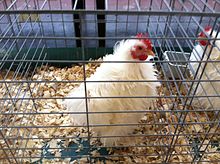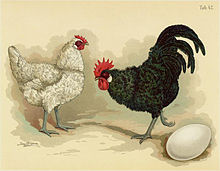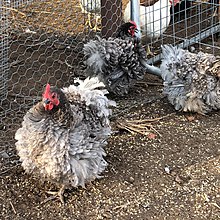Frizzle (chicken breed)
 A frizzle-feathered chicken at the Minnesota State Fair in Falcon Heights, Minnesota, USA; possibly not of the frizzle breed | |
| Use | fancy |
|---|---|
| Traits | |
| Weight | |
| Egg colour | white or tinted[1]: 121 |
| Comb type | single |
| Classification | |
| APA | no[3] |
| EE | Standard and bantam recognised[4] |
| PCGB | soft feather: heavy[5] |
| APS | Heavy Breed Softfeather[2] |
| Notes | |
| clean-legged[1]: 121 | |
| |

The Frizzle is a breed of chicken with characteristic curled or frizzled plumage. While the frizzle gene can be seen in many breeds, such as the Pekin and Polish, the Frizzle is recognised as a distinct breed in a number of European countries[4][6] and Australia.[2] In the United States, frizzled chickens are not considered a breed, and at shows are judged by the standards of the breed they belong to.[7]: 24
History
[edit]The origin of the Frizzle is unknown. The frizzle gene is thought to have originated in Asia;[8]: 137 frizzled chickens have been reported from the Far East since the eighteenth century.[6] The Frizzle breed is the result of selective breeding for exhibition.[6][9]: 102 It is recognised in nine European countries: Belgium, Czech Republic, France, Germany, Ireland, Italy, Poland, Slovakia and the United Kingdom.[4][1]
Characteristics
[edit]The gene for the curling of the feathers is incompletely dominant over normal plumage; not all members of the breed have frizzled feathers. Frizzled birds are heterozygous for the gene; when two are bred, the offspring inherit the gene in the usual Mendelian 1:2:1 ratio: 50% are heterozygous and frizzled like the parents, 25% have normal feathering, and 25% are "over-frizzled", with brittle feathers resembling pipe-cleaners. The Frizzle has a single comb and is clean-legged – without feathers on the shanks.[1]: 121 It is a good forager and is hardy.[6]
Four colours are recognised in the Entente Européenne standard: black, blue, cuckoo and white.[4] The Poultry Club of Great Britain recognises nineteen colours for both standard and bantam sizes;[10] not all of them are currently bred.[6] The Australian Poultry Standards recognise black, blue, buff, white, Columbian, red and "any recognised colour".[2]
Genetics
[edit]Research suggests that the frizzled phenotype comes from a mutation within the keratin gene KRT75. A deletion that removed part of exon 5 and intron 5 ameliorated the splice site. This caused a 69 base pair deletion of the KRT75 gene.[11]
Use
[edit]
The Frizzle is reared exclusively for exhibition.[1]: 121 It is a good layer of white or tinted eggs, and frequently gets broody.[8]: 137
References
[edit]- ^ a b c d e f g h i Victoria Roberts (2008). British poultry standards: complete specifications and judging points of all standardized breeds and varieties of poultry as compiled by the specialist breed clubs and recognised by the Poultry Club of Great Britain. Oxford: Blackwell. ISBN 9781405156424.
- ^ a b c d e f Australian Poultry Standards (2nd ed.). Victorian Poultry Fanciers Association (trading as Poultry Stud Breeders and Exhibitors Victoria). 2011. p. 79 & 80. ISBN 9781921488238.
- ^ APA Recognized Breeds and Varieties: As of January 1, 2012. American Poultry Association. Archived 4 November 2017.
- ^ a b c d Liste des races et variétés homologuée dans les pays EE (28.04.2013). Entente Européenne d’Aviculture et de Cuniculture. Archived 16 June 2013.
- ^ Breed Classification. Poultry Club of Great Britain. Archived 12 June 2018.
- ^ a b c d e Welcome. The Frizzle Society of Great Britain. Archived 30 September 2012.
- ^ Carol Ekarius (2007). Storey's Illustrated Guide to Poultry Breeds. North Adams, Massachusetts: Storey Publishing. ISBN 9781580176675.
- ^ a b Frances Bassom (2009). Chicken Breeds & Care: A Color Directory of the Most Popular Breeds and Their Care. Buffalo, NY: Firefly Books. ISBN 9781554074730.
- ^ Chris Graham (2006). Choosing and Keeping Chickens. London: Hamlyn. ISBN 9780600614388.
- ^ Frizzle Breed Standards. The Frizzle Society of Great Britain. Archived 16 October 2012.
- ^ Ng, Chen Siang; Wu, Ping; Foley, John; Foley, Anne; McDonald, Merry-Lynn; Juan, Wen-Tau; Huang, Chih-Jen; Lai, Yu-Ting; Lo, Wen-Sui; Chen, Chih-Feng; Leal, Suzanne M. (19 July 2012). Roop, Dennis (ed.). "The Chicken Frizzle Feather Is Due to an
α -Keratin (KRT75) Mutation That Causes a Defective Rachis". PLOS Genetics. 8 (7): e1002748. doi:10.1371/journal.pgen.1002748. ISSN 1553-7404. PMC 3400578. PMID 22829773.
